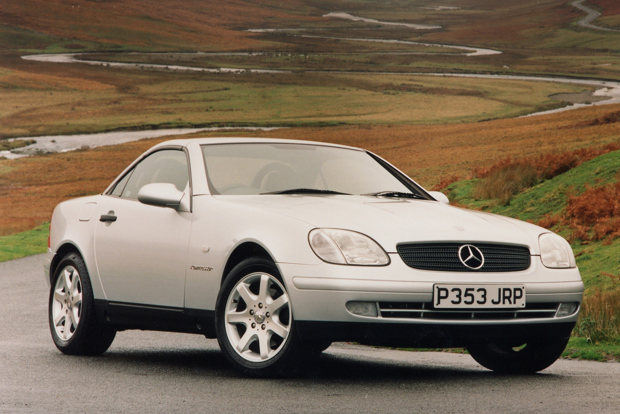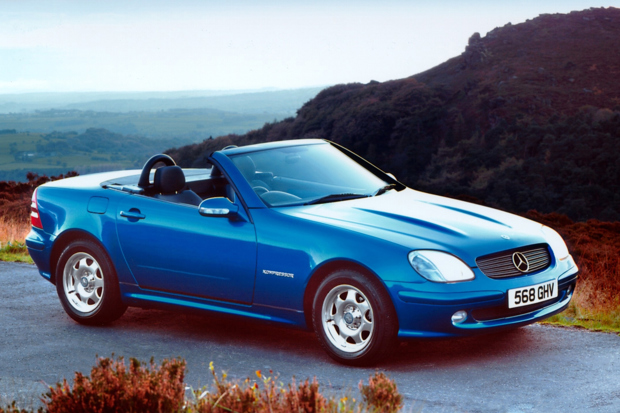Monday Motoring Classic: Mercedes-Benz SLK

Trendsetters come in all shapes and sizes and the original Mercedes SLK with its folding metal roof filled was certainly one.
It wasn’t the very first of its kind – that honour falls to a 1930s Peugeot – but it was the first to make it commercially available and it set in motion a trend that almost every other soft-top (or not, as the case may be) would follow for the next two decades.
That trend was the electric folding hardtop and it has been used since on cars as diverse as the Ferrari 458 to a rather aesthetically challenged interpretation of the bug-eyed Nissan Micra.
It was Mercedes, though, that popularised the technology. The original ‘Vario-Roof’ was first seen on the Mercedes SLK II Concept Car at the 1994 Paris Motor Show, the appearance of the prototype being so close to the final production model that it was clear from the outset that Mercedes had production intent for the model.
The Vario-Roof worked by means of a folding steel hardtop, divided in half along a transverse axis. By pressing a button on the centre console, the roof would lift and concertina away into a rear deck that lifted up on hydraulic rams, so it was safely stowed away in just over 30 seconds. As an engineering masterpiece, it was a sight to behold.
The company’s mini-SL, codenamed R170, made its European debut in April 1996 and was previewed at that year’s Turin Motor Show.
It was an instant hit. With styling cues quite clearly ripped from the bigger SL, combined with a sub-£30,000 price tag and compact dimensions, it was no surprise that there was a waiting list across Europe almost from the outset.

A waiting list so long, in fact, that buyers in the USA had to wait over a year before Mercedes started importing them and kick-started an even longer waiting list.
It didn’t matter one jot that the Mercedes SLK chassis, based on a truncated C-Class platform, was fairly wooden, or that the extra weight of the electro-hydraulic rams and steel roof made it considerably heavier than the likes of the BMW Z3 and Porsche Boxster.
The Mercedes SLK was a sports car that didn’t need to be a sports car. Dynamics came second to the posing factor and that was instantly noticeable as soon as you settled, rather comfortably, of course, behind the wheel.
There was a semblance of performance. The SLK 230 Kompressor, which was the only available model at launch, used Mercedes’s patented supercharging technology to wring almost 200bhp out of the 2.3-litre straight four engine, meaning it was no slouch. But agility was never its strong point. Nor did it need to be.
The Mercedes SLK was all about looking good and that was something it did in spades. It was popular, too, with over 310,000 built in a production run that lasted eight years.
The roof technology went on to be part of the 2001 SL range. But by then, the folding steel hardtop was commonplace with much cheaper cars like the Vauxhall Tigra and Peugeot 206CC copying the formula.

Today, the Mercedes SLK is on the cusp of collectability. Despite its premium image, though, it harks from an era where Mercedes build quality was going through a less than purple patch. Commendably, there are very few failures of the roof mechanism (Peugeot and Vauxhall, take note).
But the downside to this wonderful witchcraft comes in the form of bodywork that does its best to self-destruct. The SLK isn’t as bad as the W202 Mercedes C-Class visible corrosion (the wings, for example, tend not to self-ventilate), but rot can set in around the sills and rear arches.
And on a car where the lower half of the body structure compensates for the lack of solidity in the top half, structural rust can mean game over, so check any potential purchase carefully.
The good news is that there are many Mercedes SLKs around that have led mollycoddled lives as garaged second cars, so if you want one to cherish and preserve, these are the cars you should be looking for.
Today’s folding roofs are smaller, lighter, easier to install and much more in keeping with the DNA of a true sports car. For a while, they made the traditional ragtop redundant, although true convertibles are now undergoing something of a resurgence.
The Mercedes SLK, however, remains true to its roots in the current generation. It may be something of a niche model, but the Mercedes SLK is and was truly a game-changer. Find a classic Mercedes for sale.
How many Jaguar XK8s are there on the road?


